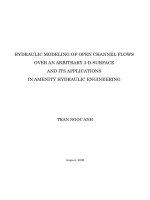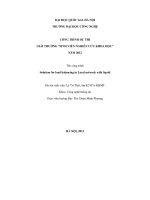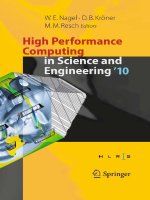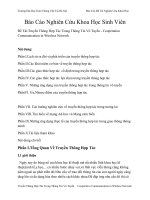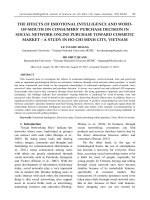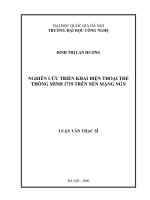btec in computing network engineering
Bạn đang xem bản rút gọn của tài liệu. Xem và tải ngay bản đầy đủ của tài liệu tại đây (5.25 MB, 37 trang )
<span class="text_page_counter">Trang 1</span><div class="page_container" data-page="1">
UNIT TITLE: ………Computer System Architecture……….ASSIGNMENT NUMBER: ………07………ASSIGNMENT NAME: Computer Systems and Operating SystemSUBMISSION DATE: …July 10, 2022………….
DATE RECEIVED: ……….TUTORIAL LECTURER: …TRAN HOANG BACH… ………WORD COUNT: …18000……….
STUDENT NAME: ……NGO MINH TUAN………STUDENT ID: ……BKC12294……….MOBILE NUMBER: …0379681318………
</div><span class="text_page_counter">Trang 2</span><div class="page_container" data-page="2"><b>Internal verification:</b>
</div><span class="text_page_counter">Trang 3</span><div class="page_container" data-page="3">P1: Identify the main subsystems of a computer and explain how they are organised and connected...6
I. CENTRAL PROCESSING UNIT (CPU):...6
1. The arithmetic logic unit (ALU)...6
2. Register... 8
3. Control Unit... 9
II. MAIN MEMORY... 10
III. I/O SUBSYSTEM... 12
P2 Explain the purpose of the Central Processing Unit (CPU) and include details on its operation...12
1. CPU purpose...12
2. Function of CPU...12
3. How CPU works... 13
M1. Review the operation of the CPU and assess its dependency and performance with regard to associated systems and subsystems... 15
I. Clock Speed...15
II. Number of Cores... 16
III. Cache and Architecture... 17
IV. Conclusion...18
P3: Describe a range of different operating systems, including the purpose, use and hardware requirements of each.... 18
I. What is an Operating System... 18
II. Function of Operating System...19
1. UI (User Interface)...19
2. Application management...20
3. Device management...21
III. Operating system types and examples...22
1. General-purpose Operating System...22
2. Mobile Operating System...24
3. Network Operation System...26
4. Real-time Operating System...27
P4: The key features associated with the architecture of an operating system...27
I. Operating System architecture...27
II. Key features of an Operating System...28
III. Summary... 29
M2 Analyse the services provided by an operating system with regard to user interaction, memory management, file management and hardware support...30
1. Definition... 30
</div><span class="text_page_counter">Trang 4</span><div class="page_container" data-page="4">security, performance and error management with regard to functionality, operation and dependency...34
P5: Explain the relationships between hardware and network addresses, including their use with regard to networking devices and components...35
I. Open Systems Interconnection (OSI)...35
II. Networking Components...41
III. Relationships between hardware and network addresses...44
P6: Set up, configure and document appropriate hardware and software systems to establish computer-based network connectivity requirements and analyse user feedback...45
I. Wired connectivity... 45
II. Wireless connectivity... 46
M3 Compare common physical and logical networking topologies and explain the differences and purposes of each... 47
I. What is Network Topology?...47
II. Types of Network Topology...47
III. Differences Between Physical and Logical Topology...49
D2 Evaluate the OSI and TCP/IP models with regard to hierarchy, layers and services, including information on theassociated protocols and hardware...50
I. Models... 50
II. Hierarchy... 50
III. Layers... 51
IV. Services...52
V. Protocols and Hardware...52
P7 Use information gathering methods to assess, troubleshoot and document solutions to a number of different technical hardware, software and networking issues...53
I. Hardware issues... 53
II. Software issues... 53
III. Network issues...53
P8 Conduct and document a range of maintenance activities with regard to computer hardware and software...54
M4: Review different diagnostic and troubleshooting skills, including data gathering methods and techniques...56
</div><span class="text_page_counter">Trang 5</span><div class="page_container" data-page="5">D3 Assess any future improvements that may be required to ensure the continued effectiveness of a computer system... 57
<b>A. Introduction.</b>
In computer engineering, computer architecture is a set of rules and methods that describe the functionality, organization, and implementation of computer systems. The architecture of a system refers to its structure in terms of separately specified components of that system and their interrelationships.
Some definitions of architecture define it as describing the capabilities and programming model of a computer but not a particular implementation. In other definitions computer architecture involves instruction set
architecture design, microarchitecture design, logic design, and implementation.
</div><span class="text_page_counter">Trang 6</span><div class="page_container" data-page="6"><b>B. Content.</b>
<b>P1: Identify the main subsystems of a computer and explain how they are organised and connected.</b>
- <b>A computer can be divided into three broad categories or subsystem: the central processing unit (CPU), </b>
the <b>main memory</b> and the <b>input/output subsystem.</b>
<b>I.CENTRAL PROCESSING UNIT (CPU):</b>
- <b>The central processing unit (CPU) performs operations on data. In most architectures it has three parts: </b>
an <b>arithmetic logic unit (ALU)</b>, a <b>control unit</b> and a set of <b>registers, fast storage locations.</b>
<b>1. The arithmetic logic unit (ALU).</b>
<b>a)</b> Definition.- An <b>arithmetic-logic unit</b> is the part of a central processing unit that carries out arithmetic and logic operations on the operands in computer instruction words. In the computer system, ALU is a main component of the central processing unit, which stands for arithmetic logic unit and performs arithmetic and logic operations.
- It is also known as an integer unit (IU) that is an integrated circuit within a CPU or GPU, which is the last component to perform calculations in the processor.
</div><span class="text_page_counter">Trang 7</span><div class="page_container" data-page="7">processors contain more than one AU -- for example, one for fixed-point operations and another for floating-point operations.
- It has the ability to perform all processes related to arithmetic and logic operations such as addition, subtraction, and shifting operations, including Boolean comparisons (XOR, OR, AND, and NOT operations). Also, binary numbers can accomplish mathematical and bitwise operations.
- The arithmetic logic unit is split into AU (arithmetic unit) and LU (logic unit). The operands and code usedby the ALU tell it which operations have to perform according to input data.
- When the ALU completes the processing of input, the information is sent to the computer's memory.
b) How does an ALU works?
- Typically, the ALU has direct input and output access to the processor controller, main memory (random access memory or RAM in a personal computer) and input/output devices. Inputs and outputs flow along an electronic path that is called a bus.
- ALU input gets signals from the external circuits, and in response, external electronics get outputs signals from ALU.
- <b>Data: Three parallel buses are contained by the ALU, which include two input and output operand. These </b>
three buses handle the number of signals, which are the same.
- The input consists of an instruction word, sometimes called a machine instruction word, that contains an operation code or "<b>opcode</b>," one or more operands and sometimes a format code. <b>Opcode</b>: When the ALU is goingto perform the operation, it is described by the operation selection code what type of operation an ALU is going to perform arithmetic or logic operation.
- The results of the ALU operations are provided by the <b>status outputs</b> in the form of supplemental data as they are multiple signals. Usually, status signals like overflow, zero, carry out, negative, and more are contained by general ALUs. When the ALU completes each operation, the external registers contained the status output signals. These signals are stored in the external registers that led to making them available for future ALU operations.
- When ALU once performs the operation, the <b>status inputs</b> allow ALU to access further information to complete the operation successfully. Furthermore, stored carry-out from a previous ALU operation is known as a single "carry-in" bit.
</div><span class="text_page_counter">Trang 8</span><div class="page_container" data-page="8">c) Pros and cons
o The bugs would occur in our result if memory space were definite.
o It is difficult to understand amateurs as their circuit is complex; also, the concept of pipelining iscomplex to understand.
o A proven disadvantage of ALU is that there are irregularities in latencies.
- A register may hold an instruction, a storage address, or any kind of data (such as a bit sequence or individual characters). Some instructions specify registers as part of the instruction. For example, an instruction may specify that the contents of two defined registers be added together and then placed in a specified register.
- A register must be large enough to hold an instruction - for example, in a 64-bit computer, a register must be 64 bits in length. In some computer designs, there are smaller registers - for example, half-registers - for shorter instructions. Depending on the processor design and language rules, registers may be numbered or have arbitrary names.
b) Operations of a CPU register.
- For CPU processing these registers plays a critical role. When we give the input, these are stored and in
</div><span class="text_page_counter">Trang 9</span><div class="page_container" data-page="9"><b>1. Fetch: To fetch the instructions of the user also the instructions that are present in the main memory in </b>
a sorted way.
<b>2. Decode: The second operation is to decode the instructions that need to perform. Thus, CPU will know</b>
what the instructions are.
<b>3. Execute: Once the instructions are decoded then execute operation is performed by the CPU. Once </b>
done the result is presented on the user screen.
<b>3. Control Unit.</b>
a) Definition.
- A control unit or CU is circuitry that directs operations within a computer's processor. It lets the computer's logic unit, memory, and both input and output devices know how to respond to instructions received from a program. Examples of devices that utilize control units include CPUs and GPUs.
- A control unit works by receiving input information to which it converts into control signals, which are then sent to the central processor. The computer’s processor then tells the attached hardware what operations to perform. The functions that a control unit performs are dependent on the type of CPU because the architecture of CPU varies from manufacturer to manufacturer.
b) Function of CU.
</div><span class="text_page_counter">Trang 10</span><div class="page_container" data-page="10">3. It controls data flow inside the processor.
4. It receives external instructions or commands to which it converts to sequence of control signals.5. It controls many execution units (i.e., ALU, data buffers and registers) contained within a CPU.6. It also handles multiple tasks, such as fetching, decoding, execution handling and storing results.
<b>II.MAIN MEMORY.</b>
a) Definition.
- Main memory is the second major subsystem in a computer.
- Main memory is sometimes called RAM. RAM stands for Random Access Memory. "Random" means thatthe memory cells can be accessed in any order. However, properly speaking, "RAM" means the type of silicon chipused to implement main memory.
- This is the part of the computer that stores operating system software, software applications and other information for the central processing unit (CPU) to have fast and direct access when needed to perform tasks. It is called "random access" because the CPU can go directly to any section of main memory, and does not have go about the process in a sequential order.
- It consists of a collection of storage locations, each with a unique identifier, called an address. Data is transferred to and from memory in groups of bits called words. A word can be a group of 8bits, 16 bits, 32 bits or 64 bits (and growing). If the word is 8 bits, it is referred to as a byte. The term “byte” is so common in computer science that sometimes a 16-bit word is referred to as a 2-byte word, or a 32-bit word is referred to as a 4-byte word.
- <b>Data word: A word can be a group of 8 bits, 16 bits, 32 bits or 64 bits (and growing). If the word is 8 bits, </b>
it is referred to as a byte. The term “byte” is so common in computer science that sometimes a 16-bit word is referred to as a 2-byte word, or a 32-bit word is referred to as a 4-byte word.
- <b>Address space: To access a word in memory requires an identifier. Although programmers use a name to </b>
identify a word (or a collection of words), at the hardware level each word is identified by an address. The total number of uniquely identifiable locations in memory is called the address space. For example, a memory with 64 kilobytes and a word size of 1 byte has an address space that ranges from 0 to 65,535.
b) Connecting CPU and memory.
</div><span class="text_page_counter">Trang 11</span><div class="page_container" data-page="11">- The CPU and memory are normally connected by three groups of connections, each called bus: data bus, address bus and control bus.
c) Memory hierarchy.
- Computer users need a lot of memory, especially memory that is very fast and inexpensive. This demand isnot always possible to satisfy— very fast memory is usually not cheap. A compromise needs to be made. The solution is hierarchical levels of memory.
</div><span class="text_page_counter">Trang 12</span><div class="page_container" data-page="12">attached to the buses through input/output controllers or interfaces. There is one specific controller for each input/output device.
<b>P2 Explain the purpose of the Central Processing Unit(CPU) and include details on its operation.</b>
- The purpose of the CPU is to process data. The CPU is where processes such as calculating, sorting and searching take place. Whatever is done on our computers, such as checking emails, playing games and doing homework, the CPU has processed the data we use.
<b>2. Function of CPU.</b>
- The function of CPU in 4 steps:
1) The CPU receives the data when the computer inputs the data through input devices such as a keyboard or mouse.
2) After this, the CPU process these input data by performing calculations and technical algorithm.3) And then CPU provides the processed data through output devices such as on the monitor screen.4) The CPU also stores the process data in the form of a cache for future use.
</div><span class="text_page_counter">Trang 13</span><div class="page_container" data-page="13">When we press any key on our keyboard, either it is an alphabet (a, b, c, …), numerical (1, 2, 3, …), or special symbol, the keyboard converts it into computer language (Binary code: 010101).
Then CPU calculates how to display the letter input pixel by pixel on the computer screen. The CPU requests step-by-step instructions from memory to draw the letter we have pressed on thekeyboard runs these instructions, and stores the results as pixels in memory.
Finally, this pixel information is sent in binary to the screen.
The screen is an output device, which converts the binary signals into the tiny lights and colours that make up what we see. This is same in the case of mouse from which your cursor/pointer on the screen. The function of CPU is not only limited to the computer screen but also other output devices of the computer like Speaker, Printer, Projector, etc…
<b>3. How CPU works.</b>
- The basic operation of a computer is called the ‘fetch-execute’ cycle. The CPU is designed to understand a set of instructions - the instruction set. It fetches the instructions from the main memory and executes them. This is done repeatedly from when the computer is booted up to when it is shut down.
1. The CPU <b>fetches</b> the instructions one at a time from the main memory into the registers. One registeris the program counter (pc). The pc holds the memory address of the next instruction to be fetched from main memory.
2. The CPU <b>decodes</b> the instruction.3. The CPU <b>executes</b> the instruction.4. Repeat until there are no more instructions.
</div><span class="text_page_counter">Trang 14</span><div class="page_container" data-page="14">- Since the data is in a disordered manner, when an instruction is divided into several smaller sets, the program counter (PC) holds the instructions’ addresses to provide the instructions serial wise to perform as per the need.
- In this way, the CPU gets to know the order of receiving the instructions. These instructions are stored in the IR (Instruction Register). Once this is completed, the program counter will continue to reference its following instructions address.
c) Executing
- At last, decoded instructions are executed. Finally, the computer has to carry out the instruction during the execution step. This could be many things, including loading data from memory, storing data in memory, or performing a calculation.
- After which, they are stored in the CPU register as output so later instructions can reference them.- After this, as per the user’s instructions, it is either given to the output device, or it is stored on the computer system, or even stored on secondary storage devices.
- The processor will carry out this cycle over and over millions of times per second.
<b>-</b> A single piece of program code: “area = length * width” might require several instructions:1. First, the computer needs to load in the value of the variable <b>length</b> into the immediate access store
(registers).
</div><span class="text_page_counter">Trang 15</span><div class="page_container" data-page="15">variable <b>area</b>.
<b>M1. Review the operation of the CPU and assess its dependency and performance with regard to </b>
<b>associated systems and subsystems.</b>
<b>-</b> A computer’s speed is heavily influenced by the CPU it uses. There are three main factors that affect how quickly a CPU can carry out instructions:
1. Clock speed2. Cores3. Cache
</div><span class="text_page_counter">Trang 16</span><div class="page_container" data-page="16">- The performance of a CPU in Hz affects mostly single-threaded applications. Most modern software, like the popular Chrome and Firefox browsers, is designed to take advantage of multiple cores (more about this in the next section) and threads, rather than solely depending on the clock speed. Typically, the computer would perform better on a CPU with multiple cores but slower clock speeds than a quicker but single-core one.
<b>II.Number of Cores</b>
- A CPU is traditionally made up of a processor with a single core. Since increasing the actual speed becameharder and harder to pull off, CPU manufacturers decided to add multitasking capabilities by adding more cores to the CPU.
- A CPU with two cores, called a dual core processor, is like having two processors in one. A dual core
</div><span class="text_page_counter">Trang 17</span><div class="page_container" data-page="17">same period of time.
- By co-existing on the same die, the individual cores of a multicore CPU share some resources, both to cut down manufacturing costs and improve performance. For example, they might share a piece of cache memory, the connections to other elements on a motherboard, etc.
- Multicore CPUs can be homogenous or heterogeneous. Homogenous CPUs contain two or more identical cores. Heterogeneous CPUs contain cores of different types. For example, the CPUs in modern smartphones usually include a central core that’s better at general operations and multiple smaller ones that help with photography, A.I., etc.
- The main downside of using quad core processors is that they are more expensive to design and make, and they also use more power than single or dual core processors. Another disadvantage is that the instructions have to be split up to decide which core will execute them and the results have to be merged together again at the end, which slows the processor down a little.
<b>III. Cache and Architecture.</b>
- A <b>cache</b> is a tiny block of memory built right onto the processor, which is effectively a small and extremely fast memory, is added to the CPU to store immediate instruction from the RAM.
- The most commonly used instructions and data are stored in the cache so that they are close at hand. The bigger the cache is, the more quickly the commonly used instructions and data can be brought into the processor and used.
- There are different levels of cache. Level 1 (L1) cache is the most basic form of cache and is found on every CPU. Level 2 (L2) cache has a bigger memory size and is used to store more immediate instructions. In general, the L1 cache caches the L2 cache, which in turn caches the RAM, which in turn caches the hard-disk data. With the newer multi-core technology, there is even an L3 or L4 cache that is bigger in size and is shared among the various cores.
<b>IV. Conclusion.</b>
- Bottom up, the processor or CPU is responsible for executing all the processes. That’s why, without a
</div><span class="text_page_counter">Trang 18</span><div class="page_container" data-page="18">office network (LAN) to the internet (WAN). It generally has a plugged-in internet cable along with cables that connect computers on the LAN. Alternatively, a LAN connection can also be wireless (Wi-Fi-enabled), making the network device wireless. These are also referred to as wireless access points (WAPs).
<b>Hubs, bridges, and switches: </b>Hubs, bridges, and switches are connecting units that allow multiple devicesto connect to the router and enable data transfer to all devices on a network. A router is a complex device with the capabilities of hubs, bridges, and even switches.
<b> Hubs: </b>A hub broadcasts data to all devices on a network. As a result, it consumes a lot of bandwidth as many computers might not need to receive the broadcasted data. The hub could be useful in linking a few gaming consoles in a local multiplayer game via a wired or wireless LAN.
<b> Bridges:</b> A bridge connects two separate LAN networks. It scans for the receiving device before sending a message. This implies that it avoids unnecessary data transfers if the receiving device is not there. Moreover, it alsochecks to see whether the receiving device has already received the message. These practices improve the overall performance of the network.
<b> Switches: </b>A switch is more powerful than a hub or a bridge but performs a similar role. It stores the MAC addresses of network devices and transfers data packets only to those devices that have requested Thus, when the demand is high, a switch becomes more efficient as it reduces the amount of latency.
</div>